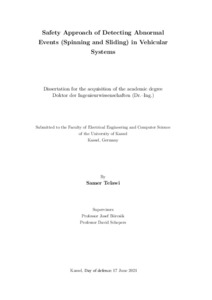| dc.date.accessioned | 2021-08-03T11:16:54Z | |
| dc.date.available | 2021-08-03T11:16:54Z | |
| dc.date.issued | 2021 | |
| dc.identifier | doi:10.17170/kobra-202108024471 | |
| dc.identifier.uri | http://hdl.handle.net/123456789/13067 | |
| dc.language.iso | eng | eng |
| dc.rights | Attribution-NonCommercial-NoDerivatives 4.0 International | * |
| dc.rights.uri | http://creativecommons.org/licenses/by-nc-nd/4.0/ | * |
| dc.subject.ddc | 620 | |
| dc.title | Safety Approach of Detecting Abnormal Events (Spinning and Sliding) in Vehicular Systems | eng |
| dc.type | Dissertation | |
| dcterms.abstract | The primary theme in the vehicles industry is the increase in automating and integrating more robust intelligent electronic systems to enhance the safe functioning, flexibility, and to extend the virtual productive age of the vehicular systems. Further, significant efforts focus on developing monitoring systems for the abnormal driving conditions such as wheel spinning and sliding that can increase the hazardous in the operating environment and speed up the wearing off process. Thus, these events play a primary role in influencing the safety of the involved humans and determining the vehicle’s lifelong as well as the incurred maintenance costs because of the encumbrances by the generated vibrations and shocks. However, the existing measurement systems are not compatible with being used in safety-critical environments because their initial development did not concern the terms of functional safety. Further, the current systems depend on a costly sensory system that requires strict, complex installation procedures. Therefore, the prevention of wheel spinning and sliding events by a safety-related miniaturized digital intelligent monitoring system comes to a corresponding meaning. Accordingly, this research work investigates the development of a novel safety-related platform following the standard IEC 61508 for monitoring and controlling the abnormal driving conditions through vibration sensors incorporated with rotation sensors. Besides, the research work tests the novel system on a locomotive where the experiments reveal some recognition patterns of the targeted events with some barriers that hinder the detection. Therefore, the research work improves the system and tests it on a generic prototype vehicle where the conducted experiments prove the capability of the system to detect the events with high accuracy. Further, the evaluation of this novel approach shows that the system represents a significant enhancement for various similar researches and applications. | eng |
| dcterms.accessRights | open access | |
| dcterms.creator | Telawi, Samer | |
| dcterms.dateAccepted | 2021-06-17 | |
| dcterms.extent | xxiv, 222 Seiten | |
| dc.contributor.corporatename | Kassel, Universität Kassel, Fachbereich Elektrotechnik / Informatik | ger |
| dc.contributor.referee | Börcsök, Josef (Prof. Dr.) | |
| dc.contributor.referee | Schepers, David (Prof. Dr.) | |
| dc.subject.swd | Kraftfahrzeugelektronik | ger |
| dc.subject.swd | Überwachungseinrichtung | ger |
| dc.subject.swd | Fehlererkennung | ger |
| dc.subject.swd | Fehleranalyse | ger |
| dc.subject.swd | Reifen | ger |
| dc.subject.swd | Technische Sicherheit | ger |
| dc.subject.swd | IEC 61508 | ger |
| dc.type.version | publishedVersion | |
| kup.iskup | false | |
| ubks.epflicht | true | |


